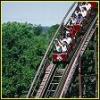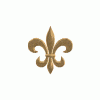Website Version
Step 1: Placing the station
The first thing you have to do is find a good spot for the station. You want a place that will allow you make a good station building around it. You might also want to consider how the coaster will be finishing. Will the surroundings near your coaster make it difficult to make a track that returns to the station?
I placed mine at the bottom of a mountain leaving the plenty of space behind and around the station. Image
Step 2: The lift hill
The height of the lift hill should be relative to how big you want your coaster to be. A high lift hill with a short track will give you a fast coaster (Great for thrill machines). A short lift hill with a long track will give you a rather slow coaster (Great for adventure rides). A short lift hill with a short track will give you a slow, mild coaster (Great for kiddie rides). A high lift hill with a long track will probably be very intense especially on a compact inverted coaster. Try to avoid using that.
Mine is 100 feet high and goes to the peak of the mountain. Image
Step 3: The first drops
As a good rule of thumb, the first drop should be big. You have to get the train off the lift hill and you want it to be as thrilling as possible. There are many ways to make a first drop. You can make a simple one like Goliath's, a twisted one like Batman's, or even a vertical one like Oblivion's (well a vertical drop isn't possible on a compact inverted coaster but you get the point).
I made a twisted drop and followed it with a hill going over another peak of the mountain. Image
Step 4: Laying the track
This is the longest and most difficult part of designing a coaster. It's such an open-ended part of coaster building that the only way to really become good at it is experimenting yourself and observing other's designs. There are some useful tips specifically for compact inverted coasters.
One: Don't use too many inversions. Inversions while they add excitement also add intensity. A four thousand foot coaster shouldn't have more than six inversions. I used only one inversion in my coaster. Image
Two: Use a lot of different elements besides inversions. Here's a few I used: a helix, a swooping drop, and back-to-back helixes. I'm surprised that the back-to-back helixes element is not very common. I think it can really add beauty to coasters, especially inverted types.
Three: You should try to make it interact with the evironment. Near misses at high speeds are the best. Terrain hugging coasters can also look very good. The land is always your friend when it comes to making coasters. Tunnels are also very good for creating excitement. A lot of short tunnels are better than a few long tunnels. Here's one such place on my coaster. Just after a high turn and a steep drop, the train rushes past sharp rocks on both the left and right side and then into a short tunnel.Image
Step 5: Reconnecting to the station
When reconnecting the track to the station it's important to make it look like it flows. Avoid using s-bends here, they can make your coaster look sloppy. If you started the coaster with plenty of space behind the station this should not be a problem. Don't forget to use brakes to slow the coaster before making sharp or unbanked turns. Using block brakes is always a good idea and it makes coasters more realistic. You might have to do some train sychronizing to make sure the trains don't stop at the top of the lift hill while they're waiting for the other train to make it past the next block section.
Here's my brake run. Notice how well the track just flows and isn't forced or sloppy.Image
Step 6: Statistics and tweaking
After testing your coaster and making sure it gets through the entire circuit, check the ride stats. Make sure intensity and nausea are not too high and excitement not too low. Usually there's not a problem with intensity and nausea being too low, in fact the lower the better. But if they're too high there can be several reasons for it. First of all, inverted coasters are always going to be more intense than sit-down coasters. It's just the way it is. Another reason could be track length. Once tracks start getting up to 4500 feet or longer intensity goes up and excitement quickly goes down. Too many inversions also cause high intensity. High g-forces can really bring intensity up. To avoid this try not going through inversions too fast and bank fast turns. You might have "tweak" the track to fix these problems, that is make small changes to the track but not changing the overall basic layout.
Here are the statistics of my coaster. Image
Step 7: Coaster add-ons
Making the layout is only half of a coaster. The second half is adding everyting around. This is mostly in the form of scenery but there are some other things too. The most obvious thing is of course the queue line. You should attempt to make the queue line follow somewhat close to the coaster itself. That way those people standing in line can see the ride and get their hearts pounding before riding the actual coaster. Of course make the line connect back to the main footpaths.
Here's the two pieces of the queue line on my coaster. Image Image
You can also and should make a building around the station. Buildings are on almost every coaster in the world so doing so just makes your coaster that much more realistic. Try to include a platform next to the station track and make sure you can see inside the building at least a little bit. Don't forget to cover the entrance and exit buildings.
In addition to a the station I added what's called a transfer station. This is used in reall life to transfer trains on and off the track so that they don't wear down so fast (In RCT2 it doesn't really work but it looks nice). I made sure that I used similar scenery on both the normal and transfer stations. Image
Finally, add in scenery around the coaster's track. This cannot be emphasized enough. There is no such thing as a good coaster without scenery in RCT2. Use trees, bushes, buildings, other tracks, water, fountains, waterfalls, anything. This is especially important with adventure rides or slow rides because obviously the speed isn't giving the ride much excitement.
Here's an overview of my coaster with scenery added in. I used custom supports, trees, and shrubs. This also shows a part of the rest of my park. Image
Thankyou for reading this tutorial and I hope it has been helpful. If you would like to download this park you can do so from this page.
**website version added-mf59**
Edited by marinersfan59, 12 February 2006 - 09:37 PM.


















